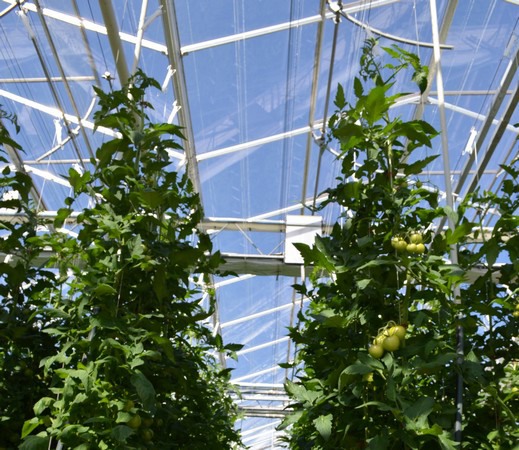The ideal greenhouse roof combines high light transmission with a very high insulation value so that energy losses are minimized, and a path is paved to fossil-free profitable greenhouse cultivation. Until now, however, high light transmission and insulation could not be realized well together: the higher the insulation, the lower the transmission and vice versa. In this article, researchers with the project "without emission to high transmission" share their developments.

"Without emission to high transmission"
Recent research developments in the 'Kas als Energiebron' project "Without emission to high transmission" have made it possible to produce a glass that combines an anti-reflective (AR) coating with low thermal emissivity. Namely, the hemispherical light transmission of 84% is similar to low iron horticultural glass but with the emissivity of 15% instead of 89%.
Simulations indicated an energy-saving potential of around 20%. This is an important step towards cultivation concepts for intensive unexposed crops where the heat demand can go in the direction of 12 m3/m2 ae., based on Dutch weather conditions.
Based on these results, a proof-of-principle project was set up at Wageningen University & Research with financing from the 'Kas als Energiebron' program to compare this type of greenhouse glass from AGCULTURE with cultivation under standard glass for a non-illuminated tomato crop.
Greenhouse design
As part of the project, the assignment was given to use a greenhouse design to achieve the lowest possible energy consumption. Therefore, both the reference and the greenhouse with low E (low emissivity) glass (Geysir) were equipped with two screens (Ludvig Svensson), a transparent Luxous 1347 FR and a dark cloth Obscura 10070 FR WB+BW and an active dehumidification system (van Dijk heating) to maximize the benefit of the high insulation level of these greenhouses. With active dehumidification, the greenhouse air is dehumidified using cold produced with a heat pump. This recovers latent heat, which serves as the driving energy for that same heat pump. The heat from the heat pump that is not needed in the dehumidification process can then be used for greenhouse heating. In this way, the heat supply of this greenhouse is mainly filled in electrically.
On December 29, the variety Marinice (de Ruiter), with a plant density of 2.5 stems/m2, was planted. The cultivation will continue until mid-November.
Where we are now
Now, at the beginning of June, it is good to take stock of what has happened and where we stand.
To start with the good news, nothing has happened up to now that was not already apparent from the model calculations. As expected, the greenhouse with the low E glass heats up a bit faster and cools down a bit slower. As a result, ventilation is often faster, and CO2 use is slightly higher than in the greenhouse with the standard glass. The heat demand of the greenhouse with low E glass is so far 23% lower than the greenhouse with the standard glass of 46 compared to 61 kWh/m2. This corresponds to 5.3 and 6.9 m3 of natural gas eq. per m2, respectively. We are therefore well on the way to achieving the target of 10 m3/m2 heat demand for the entire year. We do not heat the greenhouse with a boiler or CHP but mainly with the heat pump, which is driven by electricity. Because dehumidification plays a major role here, the intermediate position in electricity use is for now 22.5 for the low E and 28 kWh/m2 for the greenhouse with standard glass. Because when we plant in December, the plants are still very small and evaporate very little, there is absolutely no dehumidification demand in the first month. In this system, the heat demand cannot be (efficiently) met by a heat pump. This is what we call the imbalance. This imbalance is filled with a boiler and depends, among other things, on the size of the dehumidification system. Besides the electricity used by the heat pump, the boiler in the low E greenhouse used 19.1 and in the greenhouse with standard glass 17.7 kWh/m2, corresponding to 2.2 and 2.0 m3 of natural gas eq. per m2. Towards the future, precisely filling this imbalance becomes a challenge.
The BCO members and we are also satisfied with the progress of the crop. The crop is strong and well-balanced. Because of the weather conditions in March, the greenhouse with low E glass (Geysir) was a bit warmer, and the development of the crop was somewhat faster, resulting in half a truss ahead of the flowering stage. This has translated into a slight advantage for the low E (Geysir) greenhouse in the harvest so far, 9.1 kg/m2 versus 8.6 kg/m2. All other crop characteristics, such as leaf length, head thickness, and growth, are almost the same.
The coming months will show how the crop will perform under summer conditions.
For more information about the trial:
Wageningen University & Research
Frank Kempkes
frank.kempkes@wur.nl
www.glastuinbouw.wur.nl
For more information about the glass:
AGCULTURE
Mohammad Shayesteh
mohammad.shayesteh@agc.com
www.agculture.eu
